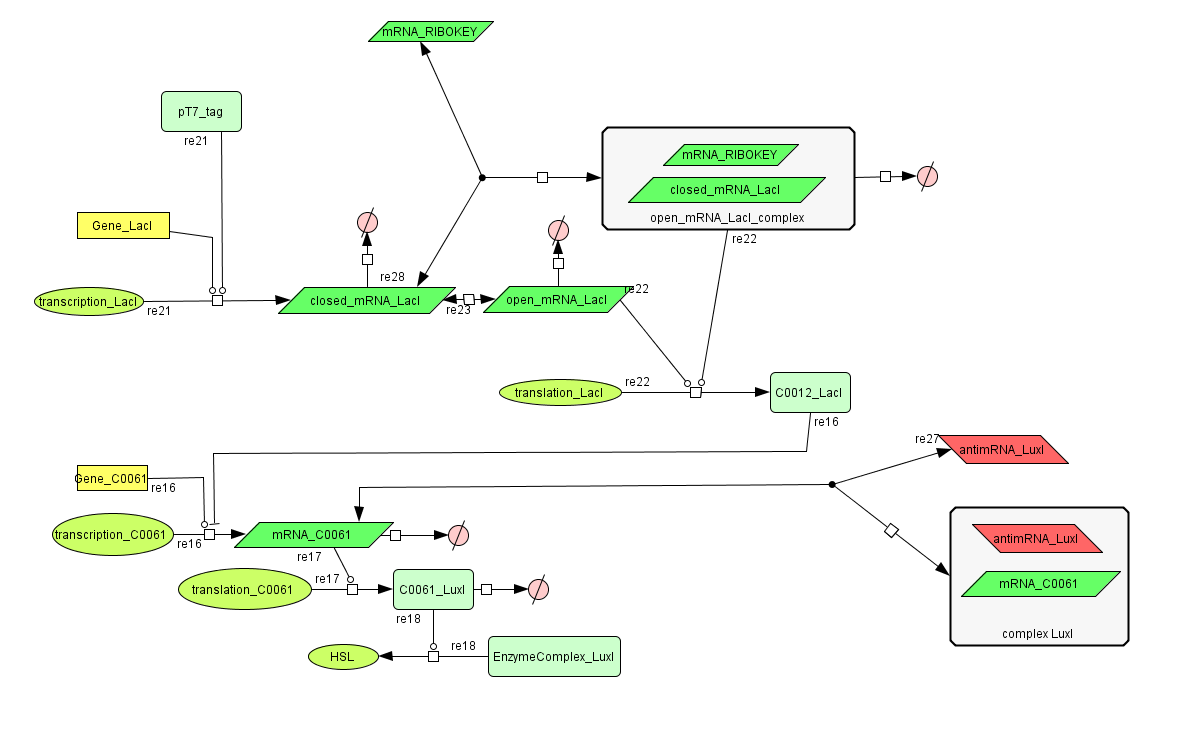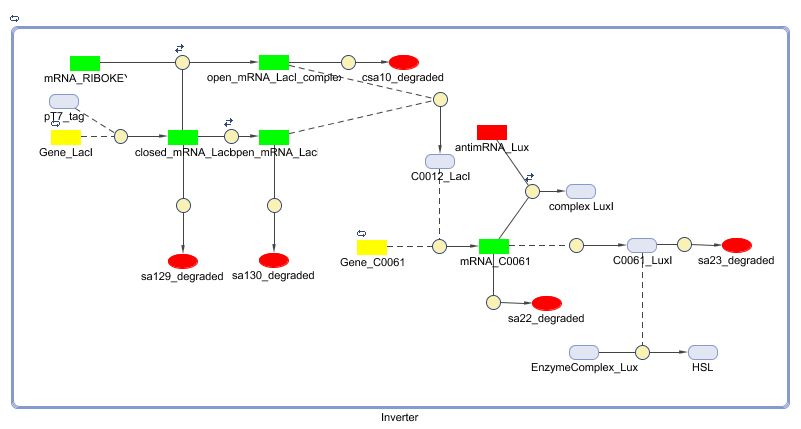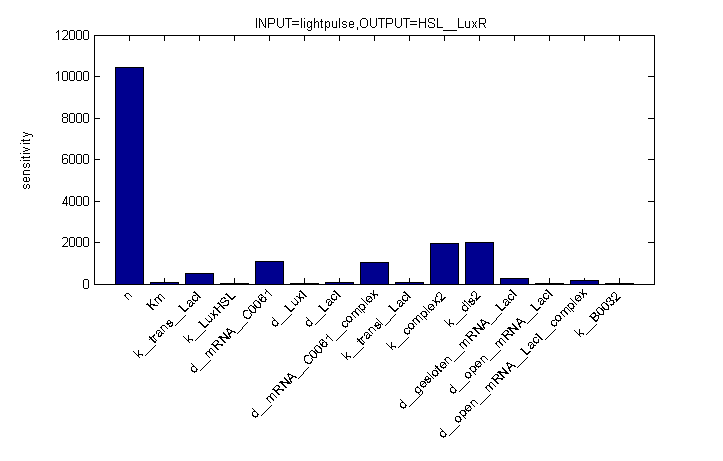Team:KULeuven/Model/Inverter
From 2008.igem.org
m (→Simulations) |
m (→Simulations) |
||
| Line 215: | Line 215: | ||
|} | |} | ||
| - | The simulation shows a working inverter. A small disadvantage is the transient behaviour of the inverter: a small pulse of 1000 seconds results in a transient behaviour of +- 30000 seconds. Also for a long pulse (10000 seconds) is a long transient behaviour noticeable (40000 seconds). | + | The simulation shows a working inverter (left figure). A small disadvantage is the transient behaviour of the inverter: a small pulse of 1000 seconds results in a transient behaviour of +- 30000 seconds. Also for a long pulse (10000 seconds) is a long transient behaviour noticeable (40000 seconds). The effect of the inverter on the timer aspect is visuable in the right figure: a long pulse ( from 10000 till 11000) resets the timer (HSL drecreases till zero). After this pulse and the transient behaviour of the inverter, the timer restarts counting. The short pulse (from 200000 till 201000 seconds) only partially resets the timer. |
| - | + | <html> | |
| + | <div class="center"> | ||
| + | <div class="noborder" style="overflow: auto; width: 800px; height: 420px;"> | ||
| + | <div class="noborder" style="width: 1250px;"> | ||
| + | <img src="http://http://https://static.igem.org/mediawiki/2008/thumb/d/d1/Sim_inverter_1.png/799px-Sim_inverter_1.png" style="float: left; width: 400px; height: 400px; margin: 0 5px;" /> | ||
| + | <img src="https://static.igem.org/mediawiki/2008/2/27/HSL.png" style="float: left; width: 400px; height: 400px; margin: 0 5px;" /> | ||
| + | </div></div></div></html> | ||
=== Sensitivity Analysis === | === Sensitivity Analysis === | ||
[[Image:Sens Inverter.png|center]] | [[Image:Sens Inverter.png|center]] | ||
Revision as of 13:37, 8 September 2008
Contents |
Invertimer
Position in the system
The invertimer subsystem receives its input from the filter, T7. The invertimer's function is to produce HSL when no input is present, so a low T7 input gives rise to a high HSL output and vice versa. The production of HSL means that the cell will start a timer that eventually will be used in the celldeath-subsystem to produce ccdB. In this way the cell will die off if no desease remains present.
Describing the system
see also: Project:Invertimer
ODE's
Parameters
| Name | Value | Comments | Reference |
|---|---|---|---|
| Degradation Rates | |||
| dLuxI | dLVA = 2.814E-4 s-1 | LVA-tag reduces lifetime to 40 minutes | [http://parts.mit.edu/igem07/index.php/ETHZ/Parameters link] [http://www.pubmedcentral.nih.gov/articlerender.fcgi?artid=106306 link] |
| dRNA_LuxI | 0.0025 s-1 | [http://www.pubmedcentral.nih.gov/picrender.fcgi?artid=124983&blobtype=pdf link] | |
| dLuxI_antimRNA | 0.0045303737 s-1 | estimate: because this RNA isn't translated, it degrades faster | |
| dLacI | dLVA = 2.814E-4 s-1 | LVA-tag reduces lifetime to 40 minutes | [http://parts.mit.edu/igem07/index.php/ETHZ/Parameters link] [http://www.pubmedcentral.nih.gov/articlerender.fcgi?artid=106306 link] |
| dclosed mRNA LacI | 0.0046209812 s-1 | estimate: because this mRNA isn't translated, it degrades faster | |
| dopen mRNA LacI | 0.0023104906 s-1 | [http://www.pubmedcentral.nih.gov/picrender.fcgi?artid=124983&blobtype=pdf link] | |
| dopen mRNA LacI complex | 0.0023104906 s-1 | [http://www.pubmedcentral.nih.gov/picrender.fcgi?artid=124983&blobtype=pdf link] | |
| dHSL | 1.02E-6 s-1 | very stable in the medium, lifetime around 185h | [http://aem.asm.org/cgi/content/abstract/71/3/1291 link] |
| LuxI catalysis | |||
| kcat | 0.0166666667 s-1 | Estimated to be about 90% of Vmax in LB medium. | [http://www.pnas.org/content/93/18/9505 link] |
| T7 Transcription | |||
| KT7 | 421 | dissociation constant, recalculated to remove units | [http://www.jbc.org/cgi/content/full/279/5/3239 link] |
| kmax | 0.044 s-1 | maximal T7 transcription rate | [http://www.jbc.org/cgi/content/full/279/5/3239 link] |
| Key-Lock constants | |||
| Keq 1 | 0,015 [M] | between closed and open T7 mRNA, experimental | [http://parts2.mit.edu/wiki/index.php/Berkeley2006-RiboregulatorsMain link] |
| Keq 2 | 0.0212 [M] | between closed T7 mRNA and key unlocked mRNA complex, experimental | [http://parts2.mit.edu/wiki/index.php/Berkeley2006-RiboregulatorsMain link] |
| kdis2 | 0.00416 s-1 | derived from experimental values | [http://parts2.mit.edu/wiki/index.php/Berkeley2006-RiboregulatorsMain link] |
| kcomplex2 | 0.00237 s-1 | derived from experimental values | [http://parts2.mit.edu/wiki/index.php/Berkeley2006-RiboregulatorsMain link] |
| kclosed | 500 s-1 | derived from experimental values | [http://parts2.mit.edu/wiki/index.php/Berkeley2006-RiboregulatorsMain link] |
| kopen | 7.5 s-1 | derived from experimental values | [http://parts2.mit.edu/wiki/index.php/Berkeley2006-RiboregulatorsMain link] |
| LacI repression | |||
| KLacI | 1.0E-10 M-1 | Dissociation constant | |
| nLacI | 2.0 | Hill coefficient for LacI | [http://parts.mit.edu/igem07/index.php/ETHZ/Parameters link] |
| k_trans_LacI | 0.0025 s-1 | Estimated maximal transcription rate from R0011 | [http://partsregistry.org/Part:BBa_R0011 link] |
| Antisense LuxI | |||
| k_complex3 | 0.00237 s-1 | rate constant for formation of asRNA - LuxI mRNA duplex | |
| KmRNA_LuxI:antisense_mRNA | 4.22E14 | Complex of LuxI mRNA with antisense mRNA | |
| Translation Rates | |||
| ktransl LuxI | 0.167 s-1 | translation rate for B0032 RBS (0.3 relative efficiency) | [http://partsregistry.org/Part:BBa_B0032 link] |
| ktransl LacI | 0.167 s-1 | lock defined translation rate for LacI | |
Models
CellDesigner (SBML file)
Matlab (SBML file)
Simulations
| Time span | Input (TetR) | Results |
|---|---|---|
| A | 0.0125 | The amount LacI increases from state zero to state one because both mRNA_RIBOKEY and pT7_tag are present. This results in a repression of LuxI which decreases to zero: the input signal (TetR) is inverted. |
| B | 5E-5 | The amount LacI decreases back to state zero. The amount LuxI remains the same (state zero). |
| C | 5E-5 | LuxI changes from state zero to state one. Time span B and C form together the transient behaviour of the inverter when the input signal changes from one to zero. |
| D | 5E-5 | LuxI remains in state one: the input signal is once again inverted. |
| E | 0.0125 | A short pulse of 1000 seconds has a influence a steep decrease of LuxI. |
| F & G | 5E-5 | During time span F and G, LuxI decreases further for a while and increases back to state one. |
| H | 5E-5 | LuxI is back in state one. |
The simulation shows a working inverter (left figure). A small disadvantage is the transient behaviour of the inverter: a small pulse of 1000 seconds results in a transient behaviour of +- 30000 seconds. Also for a long pulse (10000 seconds) is a long transient behaviour noticeable (40000 seconds). The effect of the inverter on the timer aspect is visuable in the right figure: a long pulse ( from 10000 till 11000) resets the timer (HSL drecreases till zero). After this pulse and the transient behaviour of the inverter, the timer restarts counting. The short pulse (from 200000 till 201000 seconds) only partially resets the timer.


 "
"





